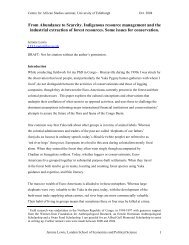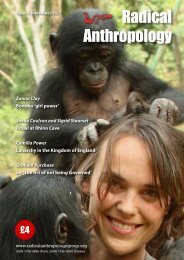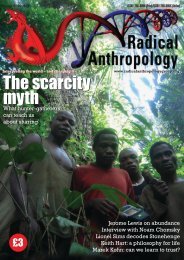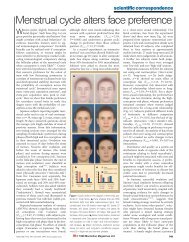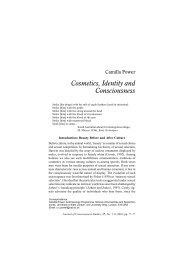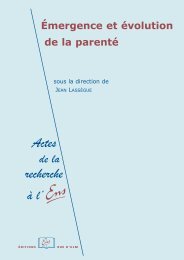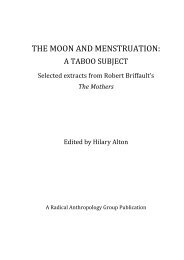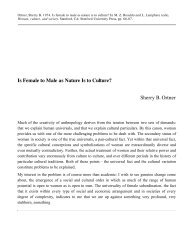Language and life history: A new perspective on the development ...
Language and life history: A new perspective on the development ...
Language and life history: A new perspective on the development ...
- No tags were found...
You also want an ePaper? Increase the reach of your titles
YUMPU automatically turns print PDFs into web optimized ePapers that Google loves.
Resp<strong>on</strong>se/Locke & Bogin: <str<strong>on</strong>g>Language</str<strong>on</strong>g> <str<strong>on</strong>g>and</str<strong>on</strong>g> <str<strong>on</strong>g>life</str<strong>on</strong>g> <str<strong>on</strong>g>history</str<strong>on</strong>g>wolves, birds, squirrels, frogs, apes, m<strong>on</strong>keys, <str<strong>on</strong>g>and</str<strong>on</strong>g> o<strong>the</strong>rn<strong>on</strong>linguistic species that are addressed in The Evoluti<strong>on</strong>of Communicati<strong>on</strong>. What, <strong>the</strong>n, is language? Chomskyresp<strong>on</strong>ds that it is “a system for expressing thought”(Chomsky 2002a, p. 76). This, he says, makes language“quite different” from <strong>the</strong> signaling systems of animals.Fair enough, but <strong>the</strong> expressi<strong>on</strong> of thought is whatpeople have in mind when <strong>the</strong>y say that language isused to communicate. It is virtually <strong>the</strong> dicti<strong>on</strong>arydefiniti<strong>on</strong>.In <strong>the</strong> target article, we discussed Hauser et al.’s (2002)distincti<strong>on</strong> between broad <str<strong>on</strong>g>and</str<strong>on</strong>g> narrow c<strong>on</strong>cepti<strong>on</strong>s of <strong>the</strong>faculty of language. Bickert<strong>on</strong> suggests that we misinterpretthis distincti<strong>on</strong> “as licensing <strong>the</strong> subsuming ofstructural <str<strong>on</strong>g>and</str<strong>on</strong>g> pragmatic elements under a singleumbrella” while evincing no awareness of <strong>the</strong> argumentsthat we actually made for <strong>the</strong> “single umbrella.” In <strong>the</strong>target article, we sampled evidence from <strong>development</strong>,evoluti<strong>on</strong>, <str<strong>on</strong>g>and</str<strong>on</strong>g> genetics. The messages from <strong>the</strong>se fieldsc<strong>on</strong>verge up<strong>on</strong> a single c<strong>on</strong>clusi<strong>on</strong>: <strong>the</strong> capacity forspeech is intimately related to o<strong>the</strong>r levels of language.Developmentally, it is evident that infants who have difficultywith word learning are likely to have problems later<strong>on</strong> with grammar or pragmatics, even if <strong>the</strong>ir lexicaldifficulties abate. Evoluti<strong>on</strong>arily, it is evident, <strong>on</strong> logicalgrounds, that grammar <str<strong>on</strong>g>and</str<strong>on</strong>g> o<strong>the</strong>r areas of language mustbe related. For if some observable behavior increasedfitness at sexual maturity, <strong>the</strong>n <strong>development</strong>al precursorswould have been incidentally reinforced – <strong>development</strong>being c<strong>on</strong>tinuous – by virtue of facilitative relati<strong>on</strong>shipsof <strong>the</strong> sort that have been documented in c<strong>on</strong>temporaryhumans. In behavioral <str<strong>on</strong>g>and</str<strong>on</strong>g> molecular genetics, analysesof individuals with problems at multiple levels of languagehave revealed str<strong>on</strong>ger or more c<strong>on</strong>sistent effects in<strong>the</strong> areas of ph<strong>on</strong>etics <str<strong>on</strong>g>and</str<strong>on</strong>g> ph<strong>on</strong>ology, effects that implya vocal influence in <strong>the</strong> <strong>development</strong> of all areas oflanguage.The commentary by Bickert<strong>on</strong> was not <strong>the</strong> <strong>on</strong>ly <strong>on</strong>e toraise c<strong>on</strong>necti<strong>on</strong>s between language <str<strong>on</strong>g>and</str<strong>on</strong>g> thought. Oneo<strong>the</strong>r, that of Van Herwegen & Karmiloff-Smith,points out that we do not say whe<strong>the</strong>r it is language thatmakes humans intelligent. These commentators claimthat <strong>the</strong> uniqueness of humans depends <strong>on</strong> <strong>the</strong> ability“to re-represent <strong>the</strong>ir representati<strong>on</strong>s into an explicitformat, transportable from <strong>on</strong>e domain of knowledge toano<strong>the</strong>r <strong>on</strong>e.” This may be true, but it has nothing to dowith our stated objective, or with any claims that wehave made.Johanss<strong>on</strong> et al. suggest that by failing to deal with “patternedc<strong>on</strong>tent” (something that also c<strong>on</strong>cerned Bright<strong>on</strong>et al., Gogate, <str<strong>on</strong>g>and</str<strong>on</strong>g> Powers) we do not actually explainlanguage. What we did do was identify <str<strong>on</strong>g>life</str<strong>on</strong>g> <str<strong>on</strong>g>history</str<strong>on</strong>g>changes that would have provided critical opportunitiesfor increased plasticity, flexibility, <str<strong>on</strong>g>and</str<strong>on</strong>g> innovati<strong>on</strong> of relevantbehaviors. We also presented arguments for <strong>the</strong>reproductive advantages of vocal, articulate, <str<strong>on</strong>g>and</str<strong>on</strong>g> referentialbehaviors during different stages of <str<strong>on</strong>g>life</str<strong>on</strong>g> <str<strong>on</strong>g>history</str<strong>on</strong>g>, frominfancy to adolescence. We made no attempt to explaingrammar, though a <str<strong>on</strong>g>life</str<strong>on</strong>g> <str<strong>on</strong>g>history</str<strong>on</strong>g> approach such as ourscould well c<strong>on</strong>verge, at some point, with <strong>on</strong>going work <strong>on</strong>ph<strong>on</strong>etic <str<strong>on</strong>g>and</str<strong>on</strong>g> ph<strong>on</strong>ological patterns (Locke 2000a;MacNeilage & Davis 2000; Ohala 2005; Studdert-Kennedy1998; 2005). It could also produce an account of vocalcomplexity that interfaces with syntax (see sect. R5).R3. Developmental c<strong>on</strong>tributi<strong>on</strong>s to <strong>the</strong> evoluti<strong>on</strong>of languageIt was gratifying to receive comments <strong>on</strong> <strong>the</strong> role of <strong>development</strong>in evoluti<strong>on</strong> by several scholars who have inspiredour own thoughts in this area. Gardner c<strong>on</strong>gratulates usfor adopting a biological framework, <str<strong>on</strong>g>and</str<strong>on</strong>g> for achieving anaccount that is more credible <str<strong>on</strong>g>and</str<strong>on</strong>g> relevant than strictly linguisticformulati<strong>on</strong>s. Bjorklund & Grotuss commend usfor focusing <strong>on</strong> <strong>the</strong> role of childhood in evoluti<strong>on</strong>. Our ownvaluati<strong>on</strong> of <strong>the</strong> young emphasized <strong>the</strong>ir creativity, in <strong>the</strong>c<strong>on</strong>texts of parental care <str<strong>on</strong>g>and</str<strong>on</strong>g> play. These commentatorscall attenti<strong>on</strong> to a possible extrafamilial c<strong>on</strong>tributi<strong>on</strong> of<strong>the</strong> young: play groups in which words are combined innovel ways to form <str<strong>on</strong>g>new</str<strong>on</strong>g> words <str<strong>on</strong>g>and</str<strong>on</strong>g> rudimentary syntax.They also point to <strong>the</strong> unusual plasticity of <strong>the</strong> developingbrain, suggesting that this might have endowed <strong>the</strong> youngwith a resp<strong>on</strong>siveness to envir<strong>on</strong>mental change surpassingthat of mature individuals. We see merit in both ideas, <str<strong>on</strong>g>and</str<strong>on</strong>g>also in <strong>the</strong>ir suggesti<strong>on</strong> that language, <str<strong>on</strong>g>and</str<strong>on</strong>g> its antecedents,may have altered <strong>the</strong> c<strong>on</strong>texts in which <strong>the</strong> young found<strong>the</strong>mselves, exposing <strong>the</strong>m to novel selecti<strong>on</strong> pressures.One change of c<strong>on</strong>text may have involved increases in<strong>the</strong> size of working groups. In hominins, <strong>the</strong> ability tospeak may have facilitated <str<strong>on</strong>g>new</str<strong>on</strong>g> levels of organizati<strong>on</strong>,enabling increases in group size. This would haveincreased cooperati<strong>on</strong> in some areas, such as predatordefense, while increasing within-group competiti<strong>on</strong> forphysical resources (Locke 2005), though a reverse-ordereffect has been argued in which larger groups encourageda transiti<strong>on</strong> from manual to vocal grooming <str<strong>on</strong>g>and</str<strong>on</strong>g> speech(Dunbar 1993). Larger groups would also have increasedsociosexual competiti<strong>on</strong>, as we suggested earlier, whichmay have affected males <str<strong>on</strong>g>and</str<strong>on</strong>g> females, <str<strong>on</strong>g>and</str<strong>on</strong>g> <strong>the</strong>ir uses ofvocal <str<strong>on</strong>g>and</str<strong>on</strong>g> verbal behavior, differently (see sect. R4).When Kuiper refers to “analytic decompositi<strong>on</strong>” of anenlarging “phrasal” vocabulary, he is proposing that suchan act promoted <strong>the</strong> evoluti<strong>on</strong> of grammatical mechanisms.We agree, having argued in <strong>the</strong> past that in <strong>development</strong>,too, grammatical mechanisms are pressured intoacti<strong>on</strong> by a burge<strong>on</strong>ing store of prosodic forms. In <strong>the</strong>sec<strong>on</strong>d year of <str<strong>on</strong>g>life</str<strong>on</strong>g>, about half of infants’ distinct utterancesmay be of this sort (Lieven et al. 1992; Locke 1997). Manypersist in prosodic form, seemingly immune to segmentaldecompositi<strong>on</strong>. We have proposed elsewhere that whenthis sort of material begins to overflow its memorialbanks, typically in <strong>the</strong> third year, it triggers activati<strong>on</strong> ofa system that analyses entries into elements corresp<strong>on</strong>dingto linguistic units (Locke 1993; 1997). This leads to moreefficient storage <str<strong>on</strong>g>and</str<strong>on</strong>g> permits grammatical computati<strong>on</strong>.Hence, it may be said that words <str<strong>on</strong>g>and</str<strong>on</strong>g> phrasal words not<strong>on</strong>ly precede grammar, but provide its justificati<strong>on</strong>.Johanss<strong>on</strong> et al. say that we fail to show why chimpanzeesdid not evolve language, but that “buried” in ouraccount “is <strong>the</strong> germ that may save” us. Fortunately,<strong>the</strong>y were not forced to dig too deeply to find it. Thegerms – bipedalism, pelvic narrowing, <str<strong>on</strong>g>and</str<strong>on</strong>g> helplessness –were key comp<strong>on</strong>ents of our argument. We, like Johanss<strong>on</strong>et al., proposed increases in proximity, attenti<strong>on</strong>, <str<strong>on</strong>g>and</str<strong>on</strong>g> careas key ingredients in <strong>the</strong> evoluti<strong>on</strong> of language as well as its<strong>development</strong> (Locke 1993).King <str<strong>on</strong>g>and</str<strong>on</strong>g> Cowley wish we had placed more emphasis<strong>on</strong> interacti<strong>on</strong>. We agree with Cowley that language,which is typically manifested as speech, is more often306 BEHAVIORAL AND BRAIN SCIENCES (2006) 29:3



